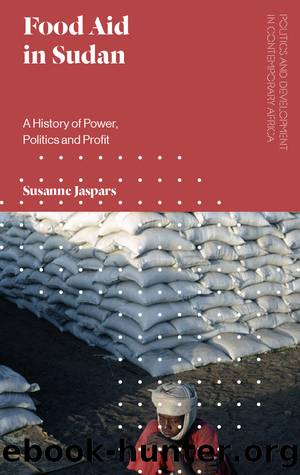Food Aid in Sudan by Susanne Jaspars

Author:Susanne Jaspars [Jaspars, Susanne]
Language: eng
Format: epub
Tags: Social Science, Developing & Emerging Countries, History, Africa, General, Political Science, Political Freedom, Peace, NGOs (Non-Governmental Organizations), Disasters & Disaster Relief, Education, Higher
ISBN: 9781786992109
Google: M_80EAAAQBAJ
Barnesnoble:
Goodreads: 36377189
Publisher: Zed Books
Published: 2018-05-15T01:04:12+00:00
The Darfur crisis: food aid in the early years (2003â07)
The humanitarian response to the consequences of conflict in 2003â04 can be seen as the peak of the livelihoods regime in Darfur. Substantial quantities of food aid reached conflict-affected populations, including rural populations from 2005, and helped reduce acute malnutrition and supported livelihoods. The aid operation supported livelihoods by lowering market prices of food, supporting cereal traders and keeping local grain markets functioning. It also provided a safe way of accessing food, thus reducing the risks of attack and rape that people faced when collecting firewood or farming. The creation of camps was a new feature of the post-2003 crisis. Al-Fashir became the site of three of the largest camps in North Darfur (Abou Shook, As Salaam and Zamzam). Smaller towns also had camps for the displaced, and in some the displaced mixed with and overwhelmed the local population (see Map 4.2). Food distribution was done on the basis of group status: IDPs in camps, displaced people with hosts and host families, and resident populations. At first, most food aid went to IDPs in camps and Arab nomadic populations were excluded, which compromised the neutrality of the operation. This section first describes the massive scale of the operation and reviews its effect on nutrition, livelihoods and power relations. In 2004â05, aid agencies could work autonomously, but from 2006 onwards government restrictions increased and access became constrained.
Effect on nutrition, food security and livelihoods
WFP delivered food aid in Darfur post-2003 in what became the largest food aid operation that Darfur has seen, not only in terms of scale but also reach: in 2005 it was able to effectively reach people in rural areas for the first time with distribution to over 3 million people at more than 300 distribution points (Young, 2007). The quantity of food aid provided was massive compared with earlier operations in Darfur; almost 450,000 MT was distributed in 2005, more than five times the amount distributed by SC-UK in 1985 and sixty times as much as that distributed in 1997.19 The ration now included six commodities â cereal, oil, pulses, sugar, salt and cornâsoy blend â instead of cereals only as in earlier operations (WFP, 2006). The number of food aid beneficiaries escalated dramatically early in the first years of the operation, from 1.2 million in April 2004 to 3.25 million by June 2005. Food aid and other humanitarian assistance were initially focused on IDPs and expanded to remote rural areas in 2005, when food distribution reached its peak (WFP, 2006). By 2008, the number of beneficiaries was close to 4 million (WFP et al., 2009). Although WFP struggled to meet needs in 2004, due to a lack of logistics capacity and of implementing partners at the start of the operation, coverage improved in 2005 (WFP, 2006) (see Figure 4.1).
The objective of WFPâs relief operation was to save lives and protect livelihoods and, initially, the large quantities of food aid distributed brought down malnutrition and mortality, lowered grain prices and supported trade.
Download
This site does not store any files on its server. We only index and link to content provided by other sites. Please contact the content providers to delete copyright contents if any and email us, we'll remove relevant links or contents immediately.
The Secret History by Donna Tartt(18849)
The Social Justice Warrior Handbook by Lisa De Pasquale(12142)
Thirteen Reasons Why by Jay Asher(8796)
This Is How You Lose Her by Junot Diaz(6795)
Weapons of Math Destruction by Cathy O'Neil(6146)
Zero to One by Peter Thiel(5686)
Beartown by Fredrik Backman(5599)
The Myth of the Strong Leader by Archie Brown(5425)
The Fire Next Time by James Baldwin(5249)
How Democracies Die by Steven Levitsky & Daniel Ziblatt(5128)
Promise Me, Dad by Joe Biden(5087)
Stone's Rules by Roger Stone(5026)
A Higher Loyalty: Truth, Lies, and Leadership by James Comey(4845)
100 Deadly Skills by Clint Emerson(4840)
Rise and Kill First by Ronen Bergman(4704)
Secrecy World by Jake Bernstein(4646)
The David Icke Guide to the Global Conspiracy (and how to end it) by David Icke(4625)
The Farm by Tom Rob Smith(4438)
The Doomsday Machine by Daniel Ellsberg(4416)
